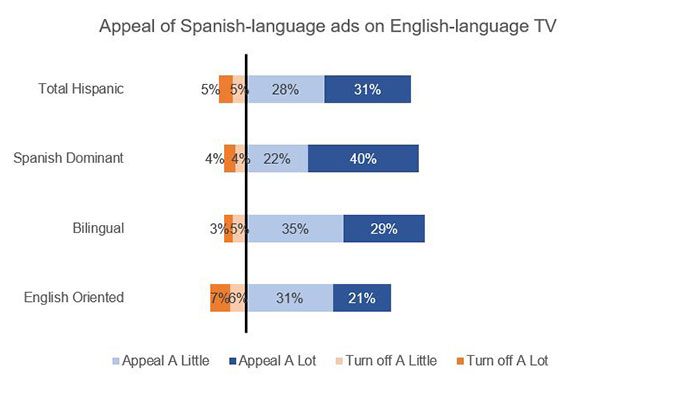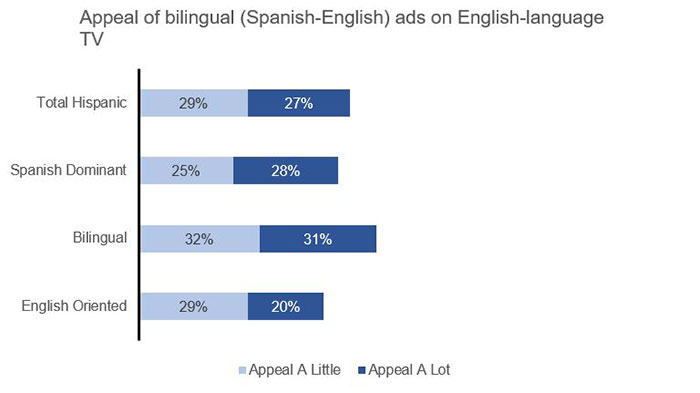For decades, the rule of thumb for US media companies and advertisers was that advertising on mainstream, English-language TV needed to be in English, and advertising on Spanish-language TV needed to be in Spanish. But the reality is that consumers’ viewing isn’t siloed, so does that rule of thumb still stand? Adriana Waterston, SVP of Insights and Strategy for Horowitz, explores the topic.
Spanish language media remains critically important, both for the Hispanic audience that consumes it and brands that are hoping to reach and resonate with that audience. According to Horowitz Research’s recent State of Consumer Engagement 2018 study, six in ten Latinos say it is appealing to them “when a brand or product advertises in Hispanic media;” this is highest among bilingual Latinos. Advertising in Hispanic media sends a strong signal that the brand recognizes and is interested in speaking to the Latino community even among those Latinos who speak both Spanish and English.
The majority of Latinos watch TV in both English and Spanish, including about six in ten Spanish-dominant, more than eight in ten bilingual Latinos, and about one-third of English-oriented Latinos. Given that this audience is exposed to content and advertising on both English-language and Spanish-language networks, brands must deliver a cohesive and authentic message across all media.
Innovative advertisers like Verizon, McDonalds, Bud Light, and Xfinity, as well as networks like ABC and Telemundo, are increasingly willing to experiment with new approaches to engage with Hispanic consumers in both Spanish and English media environments, whether by running Spanish language ads on English TV, English ads on Spanish TV, or bilingual ads in either one. Which of these tactics are most likely to resonate with consumers, and which might be a turn-off?
The State of Consumer Engagement 2018 study tackled this issue head-on, surveying consumers about how appealing these various approaches to advertising language are for them.
Advertising in Spanish in English language media appeals to six in ten Latinos. While it appeals to all segments of the market, Spanish-dominant and bilingual Latinos are especially likely to consider it appealing. On the other hand, one in ten Latinos say it would be a turn-off to see a Spanish language ad in English media, with English-oriented Latinos the most likely to say it is a turn-off— not surprising given that they are less likely to be communicating in Spanish.
Similarly, advertising in English on Spanish-language media appeals to two-thirds of Latinos, and would be a turn-off to a little over one in ten.
So what of bilingual ads? Smart bilingual advertising creative has the potential to capture the cultural as well as linguistic “code-switching” that is intimately familiar to many Latinos in the U.S. who are constantly navigating two languages, two cultures, and two different worldviews at once. Audiences are increasingly exposed to this code-switching, such as in the CW’s very successful Jane the Virgin, ABC’s long-running hit Modern Family, and Netflix’s One Day at a Time, whose recent cancellation caused an uproar among its Hispanic fans. But is the audience—and the industry—ready for bilingual ads?
Horowitz’s data suggest that the answer is yes. Seven in ten Latinos say that it would appeal to them to see a bilingual ad on Spanish-language TV, and over half would find a bilingual ad on English-language TV appealing. Importantly, the appeal of bilingual ads in both Spanish and English media is driven by those bilingual, bicultural Latinos who are constantly engaged in cultural and linguistic code-switching in their daily lives, and who form the largest and fastest-growing segment of the Hispanic market.
Of course, the audience for mainstream, English-language TV is much broader than Hispanics. Is there the potential for backlash from non-Hispanic audiences who would be exposed to those bilingual (Spanish-English) ads on mainstream TV?
The answer to this is nuanced, Horowitz’s research finds. Older, 50+ audiences are more than twice as likely to say they would find bilingual ads a turn-off (39%) than they would find them appealing (15%). Younger audiences, however, are almost three times as likely to say bilingual ads would appeal to them than say it would turn them off (among 18-34 year-olds, 41% say it would appeal and 15% say it would turn them off; among 35-49 year-olds, 44% versus 17%).
There are also notable differences by ethnicity. White, non-Hispanic and Asian audiences are split on the issue, while Black audiences are more likely to find bilingual ads appealing.
Younger consumers of all races and ethnicities have grown up in an increasingly cross-cultural and multilingual world. Content and ads that reflect America’s cultural and linguistic diversity can resonate in meaningful ways across a broad spectrum of audiences, if done well, notes
Beyond bilingual ads, there is a growing appetite for ads reflecting America’s diversity. Consumers surveyed are over four times as likely to say they would find “ads with people from different cultures, races, ethnicities, sexuality, and family styles” appealing (49%) than they are to find them a turn-off (11%). Younger and diverse audiences are the most likely to find this kind of advertising appealing.
Of course, it all comes down to the creative execution. Diverse audiences are very savvy about authenticity. They can tell when the creative and the message comes from an honest place and when it feels like pandering. This includes bilingual creative. It’s not just about throwing Spanish words into an English ad or vice-versa. It’s about understanding how linguistic code-switching and cultural code-switching are intertwined and how they manifest in everyday communications for bilingual people.





